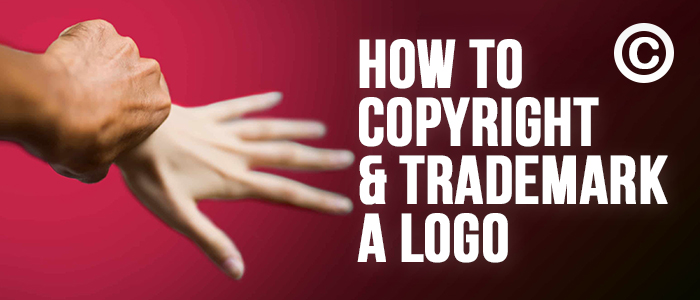There is a very thin line that separates a generic business and a brand. And it might not surprise you to know that the thin line we’re talking about is a logo. It is, inarguably, the one thing that makes a brand instantly recognizable. As such, the chance that someone steal your logo for their own brand is a chance you can’t take. So, what do you do? You go for logo copyright and trademark to ensure that nobody else can use your logo anywhere else or even think about stealing it. But how to copyright a logo? And how do trademarks work?
The answer to the question, “do I need to copyright my logo” lies in understanding what is meant by copyright or trademark a logo and how it works. Copyright is a type of intellectual property law that protects original works of authorship, such as books, paintings, and musical compositions. In the business world, copyright protection extends to logos, marketing materials, website content, and other original works created by an individual or company.
When something is copyrighted, the owner has the exclusive right to use, reproduce, distribute, publicly display, or create derivative works based on the original. Anyone who wants to use your copyrighted logo needs your permission first.
- How Important is Your Brand Identity and What Makes it Unique?
- Creating a Copyrightable Logo
- Creating an Original and Unique Logo
- Reasons to Copyright Your Logo
- What is a Common Law and Does it Protect Your Logo?
- What’s the Basic Difference Between Copyright and Trademark?
- How Do I Copyright My Logo?
- What Are the Requirements for Copyrighting a Logo?
Looking for an Affordable
Logo Design Services
Get in touch with our 24/7 available representatives now!
Chat With us to avail 30% OFF
How Important is Your Brand Identity and What Makes it Unique?
For any business owner, their brand identity is one of their most important assets. It sets them apart from the competition and helps customers remember who they are and what they do. A strong brand identity can help a business to attract new customers, build loyalty among existing customers, and increase overall sales. So, it’s no surprise that companies put a lot of time and effort into creating a unique and recognizable brand identity. Here’s what makes a strong brand identity:
- A logo is a visual representation of your brand and should be designed to be immediately recognizable and memorable.
- Choosing colors, fonts, and images that reflect your company’s values and appeal to your target audience is important.
- Not only that, but your logo should be unique to your business. This is where many businesses make the mistake of using generic images or designs..
- If your logo is too similar to another company’s, you risk being sued for trademark infringement.
- This is why it’s important to ensure that your logo is original and not likely to be confused with any other existing logos.
We at LogoVent have been long enough in the business to know how important it is for your logo to be unique in the first place. Because if you are worried about protecting it, you should ensure that it is a challenging target for someone just to copy. See some tips from our branding experts on creating a unique custom logo so that you don’t have to worry about copyright or trademark a logo.
Read more: How Much Does A Logo Cost In 2025? [UPDATED]
Looking for an Affordable
Logo Design Services
Get in touch with our 24/7 available representatives now!
Chat With us to avail 30% OFF
Creating a Copyrightable Logo
Before thinking about the question “how do you get a logo copyrighted?” You must first take a closer look at what makes a logo copyrightable in the first place. For a logo to be eligible for copyright protection, it must meet certain requirements that make it unique enough:
1. Your Logo Should be Original
To copyright a logo, it must contain a sufficient level of original and creative expression, such as unique artwork, stylized text, or graphic design. Unlike trademarks, copyright protection does not require the logo to be used in commerce. Copyright automatically applies when the logo is created and fixed in a tangible form.
However, simple logos made up of plain text, common shapes, or generic symbols may not qualify for copyright protection, though they may still be eligible for trademark protection if used in connection with goods or services.
2. Your Logo Should be Tangible
A logo must also be in a tangible form to be copyrightable. This means that it must be able to be seen, touched, or otherwise perceived by the senses. A logo that exists only in your mind is not eligible for copyright protection.
3. Your Logo Should Show Some Creativity
While there is no standard for what qualifies as “creative” work, a logo must show some creativity to be eligible for copyright protection. This can be in the form of unique colors, fonts, images, or other design elements that are not commonly used.
Learn more about branding and logo designs: What Role Does Logo Design Play In Branding?
There are certain elements that, when mixed and matched with precision, can help you come up with an original logo of your choice. Here are some tips:
There are certain elements that, when mixed and matched with precision, can help you come up with an original logo of your choice. Here are some tips:
Creating an Original and Unique Logo
When creating a unique and original logo, the sky’s the limit. However, there are certain elements that you can use to help make your logo stand out from the crowd.
1. Use Unique Fonts and Colors
One way to make your logo unique is to use fonts and colors not commonly used by other brands. For example, you could use a bold and bright color scheme for your logo if you want it to be eye-catching and memorable. Or, you could use a unique font not often seen in logos.
2. Incorporate Images or Symbols
Another way to make your logo unique is to incorporate images or symbols into the design. This can further represent your brand’s values and make your logo more recognizable.
3. Use Negative Space
Negative space is the space around the subject of an image. You can use it to create interesting effects in a logo and make it more unique. For example, you could use negative space to create a hidden image or message in your logo.
4. Keep it Simple
Sometimes, the best logos are the simplest ones. A complex logo with too many elements can be difficult to remember and may be less effective than a simpler one. When designing your logo, keep it clean and straightforward while still making it unique.
5. Think Outside the Box
There are no rules when it comes to web design. Truly. You can go as wacky or as sober as you want. As long as it reflects the values and tone of your brand, is unique enough to be eligible for copyright, and has a creative concept behind it, it’s good enough to be your logo.
By following these tips, you can create a unique and original logo. And, if you’re still unsure how to get started, our team of branding experts at LogoVent can help. We specialize in creating custom logos that are perfect for any business.
But how long should a logo design project take? Find out here.
Reasons to Copyright or Trademark Your Logo
Here are reasons other than just protecting your brand’s artistic expression.
1. Copyright Protects Your Investment
A copyrighted logo is an investment in your business. By taking the time to register your logo with the US Copyright Office, you are ensuring that you have the legal right to use and protect your brand identity. This can go a long way in preventing others from infringing on your trademark and damaging your reputation.
2. Copyright Gives You Exclusive Rights
When you copyright your logo, you are given exclusive rights to use it in commerce. This means that no one else can use it without your permission. This can be valuable if you ever need to enforce your trademark rights against an infringer.
3. Copyright Makes It Easier to Enforce Your Rights
If you have a registered copyright for your logo, you will have an easier time enforcing your rights against an infringer. This is because you can sue for infringement in federal court and recover damages.
4. Copyright Adds Value to Your Business
A copyrighted logo can add value to your business by making it more attractive to potential investors or buyers. This is because registered copyright gives your business a level of protection that unregistered trademarks do not have.
5. Copyright Gives You Peace of Mind
Knowing that your logo is protected by copyright can give you peace of mind and allow you to focus on other aspects of your business. This is because you will no longer have to worry about others infringing on your rights or damaging your reputation.
What is Common Law and Does it Protect Your Logo?
There are two main ways to copyright a logo in the United States: common law and federal registration. Common law is a type of trademark protection based on state laws instead of federal laws.
This means that common law trademarks are only protected in the state where they are used. To enforce your rights under common law, you must sue an infringer in state court.
Common law trademarks can be registered with the USPTO, but this is not required. Even if you do not register your trademark, you may still be able to assert common law rights against an infringer.
However, there are some advantages to registering your trademark with the USPTO. For example, federal registration gives you the exclusive right to use your trademark nationwide.
Additionally, it can make it easier to enforce your rights against an infringer. But if you are wondering “how to copyright a logo for free?”, the thing is you can’t. Though, you do enjoy some basic copyright protection as soon as you fix your logo.
If you are considering registering your trademark, you should consult an experienced trademark attorney.
What’s the Basic Difference Between Copyright and Trademark?
The main difference between copyright and trademark is that copyright protects original creative works, such as books, music, and artwork, while trademark protects brand identifiers, such as company names, logos, and slogans, that distinguish products or services in the marketplace.
Copyrights are governed by federal law, while trademarks are governed by state and federal law. Additionally, copyrights are typically registered with the US Copyright Office, while trademarks are usually registered with the USPTO.
Finally, copyrights generally last for the author’s life plus 70 years, while trademarks can theoretically last forever if properly maintained.
Should I Go For Copyright or Trademark?
Both copyright and trademark laws play a big role in protecting your brand, but they cover different things.
Copyright can automatically protect your logo if it includes original, creative elements—like custom artwork or a unique design. This means no one can legally copy or reuse the actual design without your permission. But copyright doesn’t protect how your logo represents your brand in the marketplace.
That’s where trademark protection comes in. A trademark helps secure your logo, name, or slogan as part of your brand identity, so others can’t use anything too similar that might confuse your customers.
By using both copyright and trademark protection, you’re covering all your bases—keeping your logo safe both creatively and commercially.
How Do I Copyright My Logo?
You must submit a copyright logo application to the US Copyright Office to copyright your logo. The application must include a copy of the logo and a work description.
The copyright office will review the application and decide whether to grant copyright protection. The copyright logo will be listed in the US Copyright Office’s public records if it is given copyright protection. The best practice in this regard is to hire a professional Copyright Service provider to help you with the registration process.
Final Thoughts
A logo is a valuable asset for any business. By taking the time to copyright your logo, you can protect your investment and add value to your business. Please contact us if you have questions about copyrighting your logo or need help enforcing your rights. Our experienced copyright logo design attorneys can help you navigate the complexities of federal trademark law.
Note: This article is intended to provide information, not legal advice.





